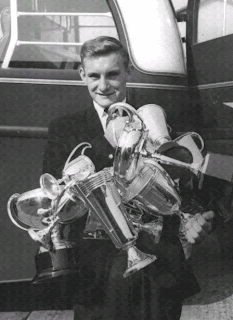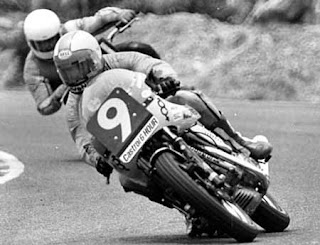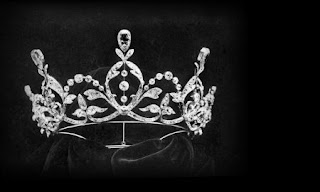Nine Times World Motorcycle Champion
Mike [The Bike] Hailwood MBE
1940 - 1981
Still the Greatest Motorcycle Racer of All Time
The Classic Hailwood
Honda 6 cylinder RC 166 Grand Prix 250
60 horsepower @ 18,000 rpm in 1966
One of the most loved and respected riders of all time, Mike Hailwood's career can be defined by extraordinary successes, under extremely difficult and dangerous conditions, executed with a humility rarely seen in today's sportsmen.
He raced and won in all the classes, including 125cc machines, despite his height. He rode "unrideable" motorcycles such as the MZ 250 and the first Honda 500 to victory. He reached the finish lines despite some frightening falls. And he won a TT race after coming back from years in retirement. He won 9 World Championships, was adored by millions and even towards the end, still did not know what all the fuss was about.
Despite being incredibly shy, with his bike racing friends, he was the life of the party, enjoyed a drink, had a quick wit and was quick to play a practical joke. He loved jazz, and he could play the guitar, the clarinet and the piano. Mike was very comfortable around women and in the 'swinging sixties' he was in his element. Rich, famous and fast. A very heady combination.
Mike returns from South Africa in 1958 as National Champion and with the trophies to prove it.
Mike Hailwood was born in 1940, the second year of World War II. Mike's father Stan had married twice. Mike was the last of three children of his first wife.
Stan Hailwood was an interesting enough person in his own right. Stan broke his leg badly as a child, and it had to be broken and re-set many times. As a result, he was largely self-schooled for two years. He left school at 13, started working for a motorcycle repair outfit at 16, and started grass-track racing at 17.
So it's easy to see how Mike had his first bike at the age of seven. The first time Mike rode it, he didn't know where the brake was, so he circled around a paddock until it ran out of fuel.
Stan Hailwood was an interesting enough person in his own right. Stan broke his leg badly as a child, and it had to be broken and re-set many times. As a result, he was largely self-schooled for two years. He left school at 13, started working for a motorcycle repair outfit at 16, and started grass-track racing at 17.
At 21, he joined a motorcycle dealer in Oxford called Kings on a month's trial. The boss was cautious about employing someone with a disability, so Stan insisted on working for commission only. He retired as the managing director 38 years later. When he retired Kings was the largest dealer in the country.
Stan was also very competitive and raced 500cc sidecars, despite his troublesome leg.
So it's easy to see how Mike had his first bike at the age of seven. The first time Mike rode it, he didn't know where the brake was, so he circled around a paddock until it ran out of fuel.
Born into a wealthy family, he was a mischievous boy. He was once caught driving his mother's Jaguar, but he didn't go that far, he couldn't see over the steering wheel.
At fourteen, he got a James trials bike, which he used to ride around a backyard grass track when home from college. His father once surreptitiously timed him, and found he was going faster than a grass track racer whom he sponsored.
Mike was not suited for college, so he worked in the family business for a while, and then his father sent him to work at Triumph Motorcycles.
He entered his first event at 17 -- the Scottish Six Days Trial. A week later, he entered his first race, on a borrowed 125cc MV Agusta. He came 11th.
A few months later, he had his international racing licence and with the help of a sizeable cheque he received from his father, he brought a semi-official MV.
After that every time he raced he won prize money and used it to buy a better bike -- first a 125cc MV Agusta, then an 196cc MV Agusta with a 240cc overbore job, and a 50cc Iton.
After that every time he raced he won prize money and used it to buy a better bike -- first a 125cc MV Agusta, then an 196cc MV Agusta with a 240cc overbore job, and a 50cc Iton.
Later that year, in 1957, he travelled with his father to South Africa to gain some overseas experience. He borrowed a 250cc NSU from John Surtees. He made enough prize money that he didn't have to give it back -- he bought it.
When he came home in early 1958, he was the South African national champion.
Back home, he started racing a 125cc Ducati, John Surtees's NSU, and 350cc and 500cc Nortons. He won the British 125, 250 and 350 championships and came second in the world 250 cc championship.
In 1958, Mike's second year of racing, he won a total of 74 races.
In 1959, he won the British 125cc championship on a Ducati, the 250cc championship on a Mondial, and the 350cc and 500cc championships on Nortons. He won the Northern Ireland 125cc GP on a Ducati, and he finished 3rd in the 125cc World Championship.
Mike poses alongside his trophy and his Ducati 250 1959
In the 250cc Isle of Man race, Mike was on an eight year old bike. Mike was leading with two of the latest Factory MV Agusta's behind him, when his ignition failed 50m from the finish.
The legend of Mike the Bike hadn't started yet. That was to happen in 1961 when Stan and Mike went back to the Isle of Man.
The was a new face in the pits at the Island that year. A Japanese motorcycle company called Honda, who were only to happy to lend Mike their little 125cc Honda racer.
The was a new face in the pits at the Island that year. A Japanese motorcycle company called Honda, who were only to happy to lend Mike their little 125cc Honda racer.
On the first two laps, Mike broke the lap record twice. Taveri, the rider he was duelling with, then broke the lap record again catching Mike. And Mike passed him and won by seven seconds.
He borrowed another Honda, this time a 250cc and raced it later that afternoon. The 125cc race was three laps of the Island, the 250cc race was five laps. Mike had raced 486km back to back in one day.
In the 350cc race, he had a two minute lead with twenty one kilometres to go, when his Norton stopped with a broken piston.
In the 500cc race, despite having a bike which was 15km/h slower than Gary Hocking's MV Agusta, he hounded Hocking until Hocking overshot a corner and took an escape road. Hocking eventually caught up, but then his Agusta broke and Mike won. In the process, Mike became the first person to average 100mph around the Isle on a British bike, and the first person to win three Isle of Man TTs in one week.
Appropriately riding a Triumph in the Thruxton 200 Mile Race in 1958
He won the 250cc races at the Dutch, East German and Swedish TT, and chased Gary Hocking's four cylinder MV Agusta 500, on his 500 Norton, so hard that Count Agusta lent him works 350 and 500 MVs for the last two races. Jumping straight from a Norton single to an MV four, Mike came first and second in the races and finished second in the world championship.
Count Agusta invited Mike to join his team for the 1962 season.
In 1962, 1963 and 1964 there were twenty seven 500cc races held. Mike Hailwood won twenty two of them. In the other five, either he did not start or he did not finish.
In 1964, Mike decided to try for the hour record at Daytona International Raceway. Using a practice bike and standard tyres, Mike rode 144.8 miles in an hour, beating the previous record by about two miles. That was in the morning. In the afternoon, he won the United States GP.
In 1965, Mike took the 500cc championship for MV Agusta again. However, the awesomely talented Giacomo Agostini had joined MV, and Count Agusta liked the idea of an Italian rider winning on an Italian bike. He started giving Mike inferior equipment, so Mike left and signed with Honda.
In his first season on Honda, he took the 250cc and 350cc championships, and came second to Agostini in the 500cc championship. He repeated this in 1967.
And his legendary fan base was growing. Mike somehow got his bike to lean angles which were greater than his competitors could achieve, but he didn't hang off the bike like modern riders do. He was famous for wearing through the leather on his boots so far that he would grind his toes on the road, with bloody results. And, perhaps as a result of his early grass track training, he would spin the rear wheel out of corners, too; a technique which was not widely used then.
And his legendary fan base was growing. Mike somehow got his bike to lean angles which were greater than his competitors could achieve, but he didn't hang off the bike like modern riders do. He was famous for wearing through the leather on his boots so far that he would grind his toes on the road, with bloody results. And, perhaps as a result of his early grass track training, he would spin the rear wheel out of corners, too; a technique which was not widely used then.
He was riding Hondas which were then at the apex of how much power could be extracted from an internal combustion engine. There was a five cylinder 125. There was a six cylinder 250. And there was a four cylinder 500cc bike that was so powerful that Honda couldn't build a frame that would contain it.
In 1967, Mike complained about that.
The next year, they squeezed even more power out of the 500cc engine. And left the frame the same. Witnesses reported the motorcycle wobbling severely as it went down straights. Another racer said Hailwood deserved a Victoria Cross if he dared ride it in an Isle of Man Tourist Trophy. He did. He pitted with a throttle grip falling off. The mechanics couldn't fix it, so one of them tied it to the handlebars with his handkerchief. Mike re-joined the race and won. In catching up, he set a lap record of 108.77mph, which stood for eight years. And then Honda pulled out of the World Championships.
The Hailwood Ducati at the Isle of Man
Mike left bikes for a while to try his hand at car racing. He raced Formula 5000, Sports cars, Formula 1 and Formula 2. He did quite well, but nowhere near as well as he had done on motorcycles. He was apparently not comfortable. He believed he was looked down upon because of his motorcycling background.
He came back to the Isle of Man in 1977. The Isle no longer had Grand Prix status (most riders thought it was too dangerous) and the promoters were willing to pay handsomely for Mike to bring some of his former glory back. Hailwood returning to the Island brought a record crowd in excess of a 100,000 spectators to jam the Mountain course, all desperate to get a glimpse of their idol.
He started twelfth in the TTF1 Superbike class, but had a nine second lead at the end of the first lap, and won the race on his Ducati, beating the second place holder by about two minutes. Since then a replica of the Ducati he rode has become a must have in any decent collection.
Hailwood on Ducati's 750 SS in Australia's Castrol Six Hour Production Race at Amaroo Park 1977
Re-enthused by his spectacularly successful return to the Isle of Man, Mike was encouraged to have a few more rides, including two trips to Australia.
Mike appeared in Australia's biggest production motorcycle race, the Castrol Six Hour at Sydney's Amaroo Park. Typically, Mike camped in the pits with everyone else, refusing any special priveleges.
At the time, I was the promoter of this event and had arranged sponsorship of the Ducati 750 SS Mike rode. Despite our relationship, Mike came up to me in the Control Tower and asked if he could buy another pit pass to get a friend into the pits. He refused accommodation in the best hotel we could find, preferring to sleep on the couch in his co-rider's lounge room.
No doubt lots of other people who came in to contact with Mike Hailwood have similar an anecdotes about their experiences.
Mike eventually became a devoted family man. He had met Pauline Fields, one of the main women in his life, when he was 19. She was an airline hostess. She later became an actor, and appeared in a few Carry On movies. She eventually married Mike in South Africa after he retired, and they had two children, David and Michelle.
Mike Hailwood MBE. GM. is still regarded as the greatest motorcycle road racer of all time.
In a mocking twist of fate, after thousands of racing miles at breakneck speeds, Mike Hailwood died in a road accident together with his young daughter Michelle on 22 March 1981.
It was a Sunday night and he was off down to the local to collect pizza for dinner when he ran into the back of a truck. An ordinary incident that turned into a disaster.
His funeral was the biggest. And for years after, leaving from the former Norton Works in Bracebridge Street, Aston, Birmingham, the Mike Hailwood Memorial Run attracted thousands of riders.
Mike Hailwood will always be the best - because he did it for the love of the sport.
It was a Sunday night and he was off down to the local to collect pizza for dinner when he ran into the back of a truck. An ordinary incident that turned into a disaster.
His funeral was the biggest. And for years after, leaving from the former Norton Works in Bracebridge Street, Aston, Birmingham, the Mike Hailwood Memorial Run attracted thousands of riders.
Mike Hailwood will always be the best - because he did it for the love of the sport.


















































